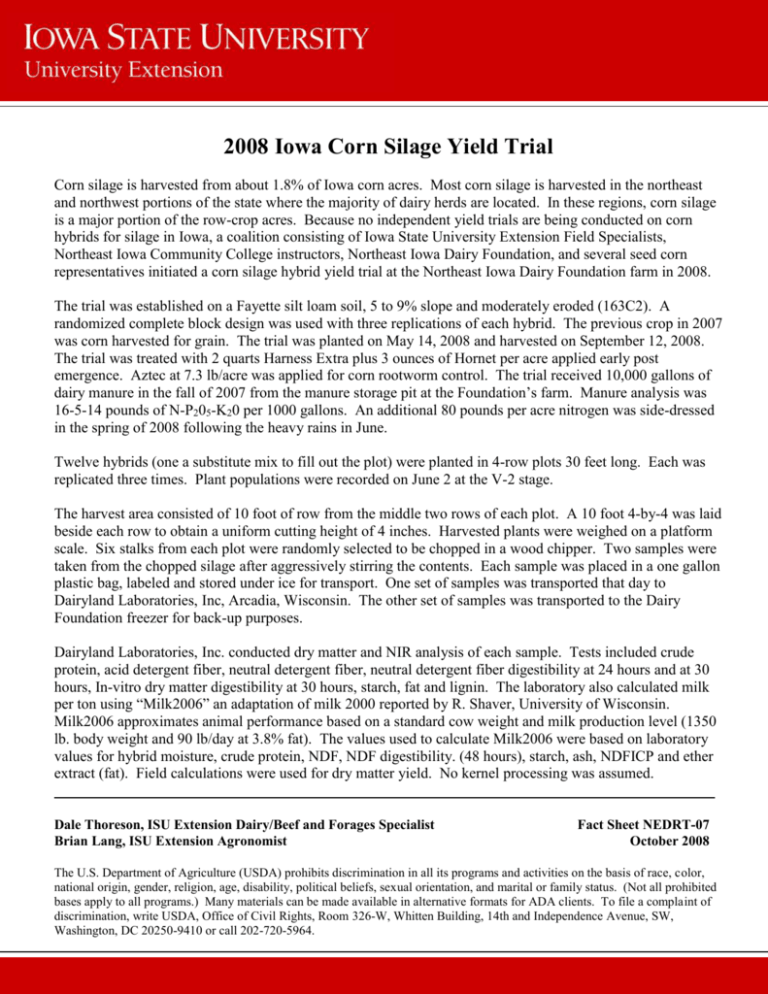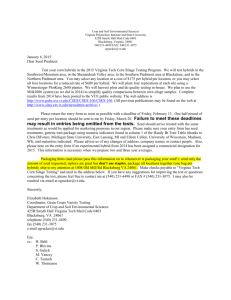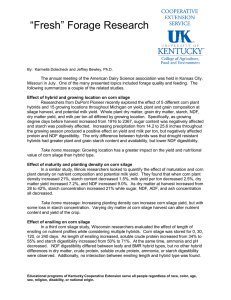Iowa Corn Silage Yield Trials – 2008
advertisement

2008 Iowa Corn Silage Yield Trial Corn silage is harvested from about 1.8% of Iowa corn acres. Most corn silage is harvested in the northeast and northwest portions of the state where the majority of dairy herds are located. In these regions, corn silage is a major portion of the row-crop acres. Because no independent yield trials are being conducted on corn hybrids for silage in Iowa, a coalition consisting of Iowa State University Extension Field Specialists, Northeast Iowa Community College instructors, Northeast Iowa Dairy Foundation, and several seed corn representatives initiated a corn silage hybrid yield trial at the Northeast Iowa Dairy Foundation farm in 2008. The trial was established on a Fayette silt loam soil, 5 to 9% slope and moderately eroded (163C2). A randomized complete block design was used with three replications of each hybrid. The previous crop in 2007 was corn harvested for grain. The trial was planted on May 14, 2008 and harvested on September 12, 2008. The trial was treated with 2 quarts Harness Extra plus 3 ounces of Hornet per acre applied early post emergence. Aztec at 7.3 lb/acre was applied for corn rootworm control. The trial received 10,000 gallons of dairy manure in the fall of 2007 from the manure storage pit at the Foundation’s farm. Manure analysis was 16-5-14 pounds of N-P205-K20 per 1000 gallons. An additional 80 pounds per acre nitrogen was side-dressed in the spring of 2008 following the heavy rains in June. Twelve hybrids (one a substitute mix to fill out the plot) were planted in 4-row plots 30 feet long. Each was replicated three times. Plant populations were recorded on June 2 at the V-2 stage. The harvest area consisted of 10 foot of row from the middle two rows of each plot. A 10 foot 4-by-4 was laid beside each row to obtain a uniform cutting height of 4 inches. Harvested plants were weighed on a platform scale. Six stalks from each plot were randomly selected to be chopped in a wood chipper. Two samples were taken from the chopped silage after aggressively stirring the contents. Each sample was placed in a one gallon plastic bag, labeled and stored under ice for transport. One set of samples was transported that day to Dairyland Laboratories, Inc, Arcadia, Wisconsin. The other set of samples was transported to the Dairy Foundation freezer for back-up purposes. Dairyland Laboratories, Inc. conducted dry matter and NIR analysis of each sample. Tests included crude protein, acid detergent fiber, neutral detergent fiber, neutral detergent fiber digestibility at 24 hours and at 30 hours, In-vitro dry matter digestibility at 30 hours, starch, fat and lignin. The laboratory also calculated milk per ton using “Milk2006” an adaptation of milk 2000 reported by R. Shaver, University of Wisconsin. Milk2006 approximates animal performance based on a standard cow weight and milk production level (1350 lb. body weight and 90 lb/day at 3.8% fat). The values used to calculate Milk2006 were based on laboratory values for hybrid moisture, crude protein, NDF, NDF digestibility. (48 hours), starch, ash, NDFICP and ether extract (fat). Field calculations were used for dry matter yield. No kernel processing was assumed. Dale Thoreson, ISU Extension Dairy/Beef and Forages Specialist Brian Lang, ISU Extension Agronomist Fact Sheet NEDRT-07 October 2008 The U.S. Department of Agriculture (USDA) prohibits discrimination in all its programs and activities on the basis of race, color, national origin, gender, religion, age, disability, political beliefs, sexual orientation, and marital or family status. (Not all prohibited bases apply to all programs.) Many materials can be made available in alternative formats for ADA clients. To file a complaint of discrimination, write USDA, Office of Civil Rights, Room 326-W, Whitten Building, 14th and Independence Avenue, SW, Washington, DC 20250-9410 or call 202-720-5964. Explanation of Quality Traits: CP = crude protein. ADF = acid detergent fiber. Acid detergent fiber represents the less digestible portion of the corn forage, containing cellulose, lignin and heat damaged protein. ADF is closely related to the digestibility of forages. Lower ADF implies the forage is more digestible. More mature plant material will contain higher ADF concentrations. A low concentration of ADF is desirable. NDF = neutral detergent fiber. This is a measure of fiber content of the corn forage. It is less digestible than non-fiber constituents of the forage. Forages with high NDF levels have lower energy. NDF is also a measure of potential forage intake. High NDF levels decrease the potential forage intake. Low NDF content is desirable. NDFD = neutral detergent fiber digestibility. The portion of the neutral detergent fiber digested by animals at a specified level of feed intake. High NDFD is desirable IVTDMD = (In-vitro) digestible dry matter. This is a measure of forage digestibility. Starch = starch from the grain, along with digestible component of the fiber, accounts for the majority of the energy in corn silage. Lignin = Lignin is the highly indigestible portion of the forage. Further Analysis of the Data Increasingly, dairy nutritionists feel there are more factors than those used in Milk2006 that are involved in ranking hybrids for farm profits across farms and over time. To determine a more accurate hybrid ranking, Mike Allen (Michigan State University), developed a partial budget program called Corn Picker for Silage that considers all economically important traits that vary by hybrid for corn silage production. The output is an estimate of the profitability of one hybrid compared to another. Hybrid inputs include dry matter yield, concentrations of NDF, CP, In-vitro NDFD and seed cost. The calculations are as follows: 1. Total corn silage needs from the hybrids compared for the entire farm. 2. Cost of corn silage produced from each hybrid including seed, production, harvest, storage, and land. 3. Adjustment for difference in cost of supplemental corn grain and soybean meal because of differences in concentrations of NDF (or starch) and CP. 4. Value of differences in milk yield and feed intake because of difference in IVNDFD. 5. The number of acres of land required for each hybrid. 6. The total cost of corn silage plus/minus adjustments for Challenger compared to cost of corn silage for Defender. Corn Picker considers the corn silage required for the entire herd and considers the intake based on the NDF digestibility of the hybrid and forage NDF concentration of the diet. It considers all costs of producing corn silage including fixed costs of storage and machinery. It adjusts for differences in supplementation with either corn or SBOM and difference in IVNDFD affect on milk yield. Difference in supplements needed and milk yield costs are adjusted for as well as the amount of land (cost/ac) need to produce the needed corn silage. Partial budgets, such as Corn Picker, account for economically important information related to corn hybrid selection that varies by farm and over time. You can download the Corn Picker Excel spreadsheet at: www.msu.edu/~mdr/cornpicker.html. Appreciation is extended to the Northeast Iowa Dairy Foundation, Northeast Iowa Community College, the seed corn dealers and volunteers who assisted in the establishment and harvest of this trial. Participating Companies: American Organics, P.O. Box 382, Warren, IL 46792 Monsanto Seed Group, DeKalb Genetics, 3100 Sycamore Road, DeKalb, IL 60115 Mycogen Seeds, 9330 Zionsville Rd, Indianapolis, IN 46268 Pioneer Hi-Bred International, 7000 NW 62nd Ave, Johnston, IA 50131 Relative Maturity (RM), Whole Plant Moisture, Dry Matter and Silage Yield, and Quality Traits for Corn Hybrids Planted at Calmar (Winneshiek County) in 2008 Hybrid RM Population V2 stage Moisture Dry Matter Yield Silage Yield CP ADF NDF NDFD 24 NDFD 30 IVTDMD 30 days plants/acre % tons/acre tons/acre % % % % % % % P34P94HXX LL 111 31,500 70.3 9.9 33.3 6.5 25.6 42.5 55.5 58.1 82.2 DKC 59-64 109 30,667 71 9.7 33.4 6.5 24.6 42 53.5 56.2 DKC 61-69 VT3 111 33,333 70.4 9.3 31.3 6.3 24.4 41.6 54.7 AO vpX-751 (Exp) 103 31,333 69.3 9.1 29.5 6.7 26.1 44.1 AO 108 33,000 68.4 9.2 29.3 6.5 27.3 46.4 P34A89 HXX LL RR2 110 29,500 70.2 9.3 31.1 6.7 26.2 P35F44 HXX LL RR2 105 32,167 70 8.8 29.4 6.6 DKC 63-42 VT3 113 33,500 71.4 8.9 31.2 MYC TMF2Q759 HXX LL RR2 MYC TMF1Q716 HXX LL RR2 MYC F2F725 HXRW LL BMR Average 113 32,667 72.4 9.4 33.9 109 33,333 71.9 8.7 113 33,500 74.2 32,227 1,882 E810-LFY-CU LSD 0.05 Starch Lignin Fat MILK 2006 per ton MILK 2006 per acre % % lbs/ton lbs/acre 30.3 3.6 2.6 3,409 33,707 81.6 31.5 3.8 2.5 3,381 32,761 58 82.5 32.2 3.8 2.7 3,441 31,800 56.8 59.4 82.1 30.2 3.7 2.8 3,485 31,555 57.1 59.8 81.3 27.7 3.8 2.6 3,387 31,318 43.9 55.8 58.6 81.8 28.6 3.5 2.6 3,378 31,266 26.1 43.9 57.2 59.9 82.3 29.9 3.5 2.8 3,494 30,815 6.8 24.7 42.2 55.7 58.4 82.5 31.3 3.7 2.8 3,487 30,398 6.2 26.6 44.2 53 55.9 80.5 27.4 4.1 2.4 3,136 29,361 31.0 6.5 27.3 46.2 55.6 58.9 80.9 27.3 3.7 2.7 3,305 28,673 8.6 33.1 6.7 27.4 46.8 58 60.6 81.6 23.8 3.5 2.5 3,192 27,221 70.9 9.2 31.5 6.5 26.1 44 55.7 58.5 81.8 29.1 3.7 2.6 3,372 30,807 1.1 0.7 2.4 0.4 1.2 1.5 2.1 2.1 1.3 1.8 0.3 0.1 119 2,721






